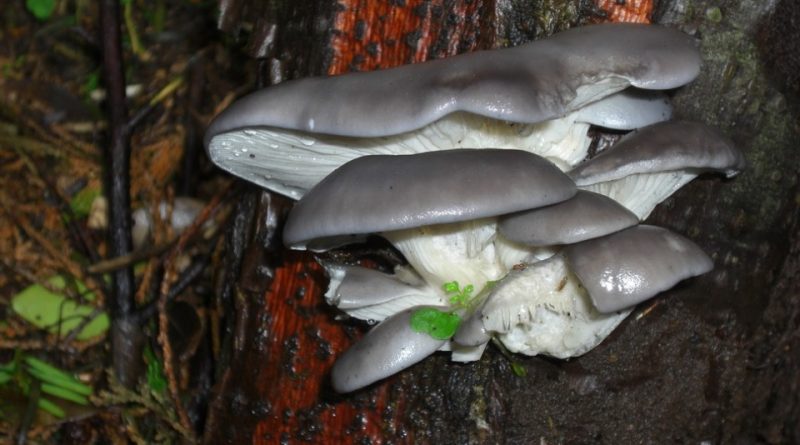Pleurotus ostreatus
Pleurotus ostreatus
The oyster mushroom or oyster fungus or hiratake, (Pleurotus ostreatus Jacq.) is a mushroom of the family of the Pleurotaceae among the most cultivated in the world.
Systematics –
From a systematic point of view it belongs to the Eukaryota Domain, Kingdom Fungi, Basidiomycota Division, Basidiomycetes Class, Order Agaricales, Pleurotaceae Family and then to the Genus Pleurotus and to the P. obeatus Species.
Etymology –
The term Pleurotus comes from the Greek πλευρόν pleurón side, flank, side and from οὖς, ωτός oús, otós ear: that is, with the hat similar to an ear placed laterally. The specific epithet, ostreatus, derives from oyster oyster: for the oyster-shaped carpophore.
Geographic Distribution and Habitat –
The Pleurotus ostreatus is a fungus that grows on old stumps, on live trunks of deciduous trees (mulberries, poplars, etc.) and bears fruit from the autumn to the following spring and also in winters with mild climate.
Description –
The Pleurotus ostreatus is characterized by a hat that already in the initial stage of growth assumes a convex shape, intimately combined with other hats that grow around it; subsequently it takes the form of oyster or fan, often bushy, imbricate with other hats, often in numerous formations. It has a color that can vary from brown-violet, reddish-brown or gray-whitish; the margin is involute and smooth but at maturity tends to smooth with a lumpy-lumpy pattern, also presenting fractures. The diameter of the hat can take from 5 to 25 cm, with a smooth cuticle, silky that becomes decidedly sticky with wet weather. The slats are dense, narrow, interspersed with lamellule, long decurrent on the stem and of color that can go from white to creamy-white or greyish. The stem of these mushrooms is lateral or eccentric, irregularly cylindrical in shape, sometimes very short, thinned at the base which often takes on a fusiform aspect; it is white or whitish, covered with grayish or brownish-gray pruina and is 2 to 6 cm tall and 1-2 cm thick. The meat is very compact, firm and white in color that smells intensely of fresh flour or rose and with flavor: sweetish, very pleasant, more aromatic and intense in the spontaneous specimens rather than those grown. The spores are white in mass, cylindrical, smooth, 8-12 x 3-4 μm.
A particularity: the Gelone is a carnivorous mushroom; in fact the mycelium can kill and digest nematodes, thus compensating for the need for the fungus in nitrogen.
Cultivation –
The oyster mushroom is one of the most cultivated and consumed ever; for its cultivation technique you can consult the following sheet.
Uses and Traditions –
Pleurotus ostreatus, in addition to being researched, also in its natural state for its excellent edibility, contains compounds that would have an anti-inflammatory, antiplatelet, antioxidant, hypocholesterolemic and stimulating immune system effect. Furthermore, this fungus produces lovastatin, a substance used as a hypocholesterolemic drug.
Preparation Mode –
Pleurotus ostreatus is a mushroom with a high yield, especially if it is younger and has excellent edibility. It is a gastronomically very versatile mushroom. It is excellent, especially if cooked on a grill, but it can be prepared in many different ways and kept either dried or in oil.
Guido Bissanti
Sources
– Wikipedia, the free encyclopedia.
– Cetto B., 2008. Real mushrooms, Saturnia, Trento.
– Pignatti S., 1982. Flora of Italy, Edagricole, Bologna.
– Conti F., Abbate G., Alessandrini A., Blasi C. (edited by), 2005. An annotated checklist of the Italian vascular flora, Palombi Editore.
Warning: Pharmaceutical applications and alimurgical uses are indicated for informational purposes only and do not in any way represent a medical prescription; there is therefore no liability for their use for curative, aesthetic or food purposes.


